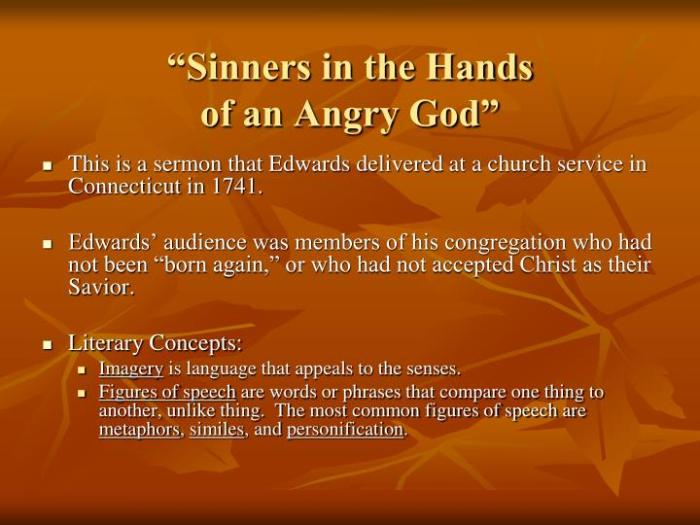Personification in Sinners in the Hands of an Angry God sets the stage for this enthralling narrative, offering readers a glimpse into a story that is rich in detail and brimming with originality from the outset. Edwards’ masterful use of personification breathes life into abstract concepts, creating a vivid and emotionally charged atmosphere that captivates the audience and leaves a lasting impression.
Throughout the sermon, Edwards employs various methods of personification to convey his message effectively. By attributing human qualities to abstract ideas, he enhances the reader’s understanding and engagement, allowing them to connect with the sermon on a deeper level.
Definition and Significance of Personification: Personification In Sinners In The Hands Of An Angry God

Personification is a literary device that attributes human qualities, emotions, or characteristics to nonhuman entities, such as objects, animals, or abstract concepts. It enhances the vividness and emotional impact of writing by making these entities more relatable and engaging. Personification is a powerful tool for conveying complex ideas and emotions, allowing writers to explore human experiences and perspectives through nonhuman subjects.
Examples of Personification in “Sinners in the Hands of an Angry God”
Edwards uses personification extensively in “Sinners in the Hands of an Angry God.” He personifies God as a wrathful judge, Hell as a devouring monster, and sinners as helpless victims. These personifications create a vivid and terrifying image of God’s judgment, emphasizing the danger and urgency of repentance.
Methods of Personification
Edwards employs various methods to personify abstract concepts. He uses direct personification, attributing human actions and emotions to nonhuman entities. He also uses indirect personification, suggesting human qualities through language and imagery. Additionally, he uses anthropomorphism, giving human form to nonhuman entities.
These methods enhance the reader’s understanding and engagement by making abstract concepts more concrete and relatable.
Impact of Personification on the Audience
Personification has a profound emotional and psychological impact on the audience. It evokes fear, guilt, and other strong emotions, making the sermon more persuasive and memorable. By personifying God and Hell, Edwards creates a sense of urgency and impending doom, motivating listeners to seek salvation.
Personification also helps shape the audience’s response by making the sermon more relatable and emotionally resonant.
Historical and Cultural Context of Personification
Personification was a common literary device in Puritan sermons. It was influenced by biblical and classical literature, which often personified God, angels, and other supernatural beings. Personification reflected the Puritan belief in the sovereignty and wrath of God, as well as the importance of repentance and salvation.
Comparison to Other Literary Works, Personification in sinners in the hands of an angry god
Edwards’ use of personification is comparable to that of other authors, such as Shakespeare and Milton. Like Edwards, Shakespeare personifies nature and abstract concepts to create vivid and memorable imagery. Milton uses personification to explore the complexities of good and evil, portraying Satan as a complex and tragic figure.
However, Edwards’ use of personification is unique in its intensity and focus on religious themes.
Modern Applications of Personification
Personification continues to be used in modern literature and other forms of writing. It allows writers to convey complex ideas and emotions in a relatable and engaging way. Contemporary works that effectively employ personification include novels, poems, and even advertisements.
Personification remains a powerful tool for shaping the reader’s experience and understanding.
Commonly Asked Questions
What is the significance of personification in “Sinners in the Hands of an Angry God”?
Personification allows Edwards to convey complex theological concepts in a vivid and emotionally engaging manner, making the sermon more accessible and impactful.
How does Edwards use personification to create a sense of urgency and fear in the sermon?
Edwards personifies God’s wrath as a consuming fire and a roaring lion, instilling a sense of terror and impending doom in the audience.
What are some examples of personification in the sermon?
Edwards personifies “sin” as a “venomous serpent,” “hell” as a “bottomless pit,” and “the wrath of God” as a “fiery oven.”


